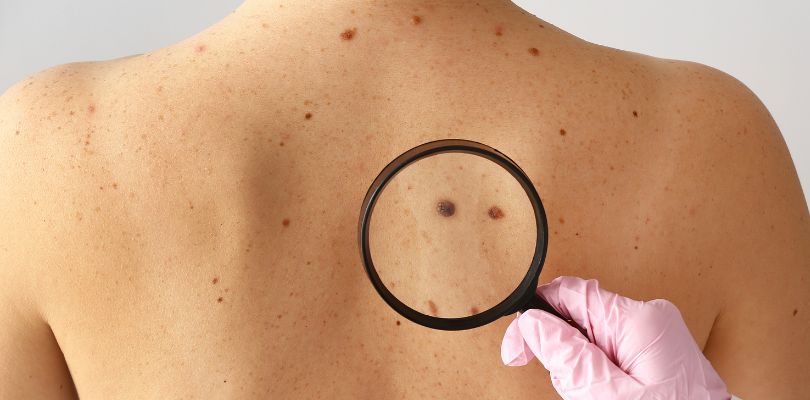Recognizing Common Signs and Symptoms is Key for Early Treatment
Skin cancer occurs when skin cells grow abnormally, often due to damage from ultraviolet (UV) radiation from the sun or tanning beds. Early detection is crucial, as it significantly improves the chances of successful treatment. In this article we review the most common signs and symptoms of skin cancer and treatment options, including the medication Erivedge, which is used to slow the growth of cancerous cells.
Common Signs of Skin Cancer
1. A New Growth or Lump on the Skin
The appearance of a new growth or lump on the skin can be an early sign of skin cancer. These growths are often small, firm, and may appear shiny, waxy or pearly in texture. While not all new growths are cancerous, it is essential to monitor any changes in size, shape or color and consult a healthcare professional for evaluation.
2. Changes in an Existing Mole
Changes in the size, shape or color of an existing mole can be a warning sign of melanoma, the most dangerous form of skin cancer. The ABCDE rule is commonly used to evaluate moles:
- Asymmetry: One half of the mole does not match the other half.
- Border: The edges of the mole are irregular, scalloped or poorly defined.
- Color: The mole has varying shades of brown, black, or even red, blue or white.
- Diameter: The mole is larger than 6mm (about the size of a pencil eraser).
- Evolution: The mole changes in size, shape or color over time.
3. A Sore That Doesn’t Heal
A sore or ulcer that doesn’t heal within a few weeks is a common sign of skin cancer, particularly basal cell carcinoma. These sores may ooze, bleed or develop a crust. They often appear on sun-exposed areas like the face, neck and hands. Persistent sores that resist healing should be examined by a healthcare professional.
4. Itchy, Tender, or Painful Skin Lesions
Skin lesions that are itchy, tender or painful can be indicative of skin cancer, especially if they persist for an extended period. While not all skin cancers cause discomfort, any lesion that causes pain or irritation should be evaluated, particularly if it changes over time.
This article will explore treatments for erectile dysfunction, looking at the best options. Read on to learn more.
5. Red or Pink Patches of Skin
Red or pink patches of skin, often rough or scaly, can be a sign of actinic keratosis, a precancerous condition that can develop into squamous cell carcinoma if left untreated. These patches usually appear on sun-exposed areas such as the face, ears, neck and hands. Regular skin checks can help identify these patches early, before they progress.
6. A Wart-like Growth
Some types of skin cancer, such as squamous cell carcinoma, may present as wart-like growths. These growths are often firm, rough and may bleed or develop a crust. Unlike common warts, which are caused by a virus, these growths are a result of abnormal cell growth and should be evaluated by a dermatologist.
7. Dark Streaks Under the Nails
Dark streaks under the nails can be a sign of melanoma. These streaks often appear as a single, narrow line of dark pigment running vertically along the nail. While not all dark streaks are cancerous, any new or unusual streaks should be checked by a healthcare professional.
8. Changes in Skin Texture
Skin cancer can cause changes in the texture of the skin, such as thickening or the development of a waxy or shiny surface. These changes are often subtle but can be a sign of basal cell carcinoma. It’s important to monitor any unusual changes in the skin’s texture and seek medical advice if they persist.
9. A Brown or Black Streak Around a Mole
The appearance of a brown or black streak around a mole can be an indication of melanoma. This streak is often irregular in shape and may expand over time. The presence of this sign should prompt immediate evaluation by a healthcare professional, as early detection is critical in melanoma cases.
10. A Mole That Feels Different to the Touch
A mole that feels different from the surrounding skin, whether it’s harder, softer or has an irregular surface, can be a sign of skin cancer. Changes in the feel of a mole, especially if accompanied by other symptoms like itching or bleeding, should not be ignored.
Treatment Options for Skin Cancer
Treatment for skin cancer depends on the type, location and stage of the cancer. Common treatments include:
- Surgical removal: This is the most common treatment, involving the excision of the cancerous tissue along with a margin of healthy tissue.
- Radiation therapy: Used to target and destroy cancer cells, particularly in cases where surgery is not an option.
- Topical treatments: Creams and ointments that are applied directly to the skin cancer to destroy cancer cells, often used for superficial basal cell carcinoma.
- Oral medications: For advanced cases, oral medications like Erivedge (vismodegib) may be prescribed. Erivedge is specifically used to treat basal cell carcinoma that cannot be treated with surgery or radiation. It works by inhibiting the growth of cancer cells and is often used in cases where the cancer has spread or recurred.
Final Notes
Recognizing the signs and symptoms of skin cancer early can significantly improve the chances of successful treatment. Regular skin checks and prompt consultation with a healthcare professional if any of these signs are present are crucial steps in managing and preventing skin cancer. With advances in treatment options, including medications like Erivedge, patients have more tools than ever to fight this common but serious disease.







